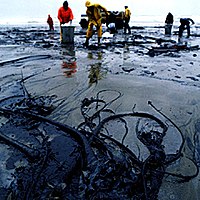
Photo from wikipedia
Oil spill identifications involve the comparison of oil fingerprints between the oil spill and suspected oil sources, defined by ratios between the abundances of oil-discriminating compounds, Diagnostic Ratios (DR). The… Click to show full abstract
Oil spill identifications involve the comparison of oil fingerprints between the oil spill and suspected oil sources, defined by ratios between the abundances of oil-discriminating compounds, Diagnostic Ratios (DR). The normalised Nordtest and EN 15522-2 methodologies use Student's t statistic (S-t) or a maximum relative difference (SC) to compare mean DR from replicate sample analysis. While the S-t method assumes the normality of DR distribution, the SC method is based on controlled DR dispersion. However, when false, the assumptions and approximations adopted can lead to low true identification rates. This work presents a novel computational tool for the statistically sound oil spill identification that allows following requirements defined by EN 15522-2, the comparison of replicate DR determinations, and the use of different DR sets and formats. The tool uses the Monte Carlo Method (MCM) to describe the probability distribution of the difference of mean DR, allowing estimating the probability of the true acceptance of fingerprints equivalence. The studied methods were applied to the comparison of signals from the same oil and to a real scenario reproduced in an International Round Robin Test. The methods were compared considering the probabilities of true acceptance of oil patterns equivalence based on a single, γ, or various, δ, DR. The MCM method performs identifications with γ equivalent to the defined confidence level for the comparison, P. Since the various DR studied are not perfectly correlated, the δ is below P. The number of replicate analyses performed and the DR considered in the comparison affect identification performance. The S-t produces comparison criteria with a γ lower than P. The SC criteria for duplicate analysis is associated with a δ lower than the obtained by the MCM. A user-friendly MS-Excel spreadsheet is available to perform oil pattern comparisons using various methods and conditions.
Journal Title: Chemosphere
Year Published: 2022
Link to full text (if available)
Share on Social Media: Sign Up to like & get
recommendations!